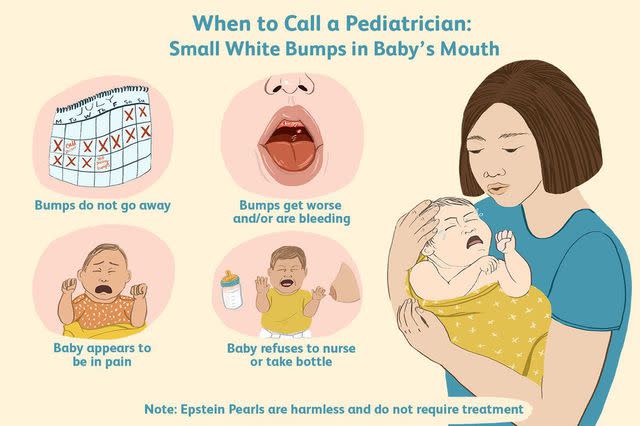What Parents Should Know About Epstein Pearls in Babies
- Oops!Something went wrong.Please try again later.
Epstein pearls are small, white bumps that form in a baby’s mouth before they're born. Learn more about them, including how they're diagnosed and treated.
Medically reviewed by Wendy L. Hunter, M.D.
Epstein pearls are tiny, harmless cysts that can appear in a newborn's mouth. They are quite common, with research suggesting that they affect up to 85% of newborns.
Epstein pearls look like tiny, white or yellowish bumps and generally appear along a baby's gums or on the roof of the mouth. They are named after Alois Epstein, MD, a Czech pediatrician who first described them back in 1880.
The good news is Epstein pearls are benign, meaning they are not dangerous for your baby. Read on to learn about what causes Epstein pearls, how they're diagnosed, and when to call a health care provider.

Parents / Jessica Olah
Related: 5 Common Baby Skin Care Issues and What To Do About Them
Epstein Pearls Symptoms
Epstein pearls are made of keratin, a protein found in hair, skin, and nails. They may resemble small pimples or unerupted baby teeth in your newborn baby's mouth. They commonly appear along the middle of the hard palate (the roof of the mouth) or the gums. Epstein pearls are also small, up to just a few millimeters in size. They may appear as a single bump or in clusters.
While hard to the touch, they are generally painless for your baby. Other than their appearance, Epstein pearls are asymptomatic, meaning they don't cause any other symptoms.
What Causes Epstein Pearls?
Epstein pearls form during fetal development. When a baby's mouth reaches the final stages of development during pregnancy, the sides of the jaw and the palate begin to fuse together. When that happens, some of the layers of skin can get stuck, leading to the formation of Epstein pearls.
In addition to occurring in the mouth, Epstein pearls can also develop on the tip of the penis, though this is more rare. This happens in about 7.3 per 1,000 newborns with a penis.
Some research has found an association between Epstein pearls and prenatal folic acid intake. However, this finding does not necessarily mean folic acid causes Epstein pearls or that folic acid increases the risk of Epstein pearls. More research is needed to evaluate if the association has any meaning related to a cause.
In general, experts believe that Epstein pearls are not preventable and are not caused by anything a parent did or didn’t do during pregnancy.
How Epstein Pearls Are Diagnosed
Although Epstein pearls are harmless and don't require treatment, if you're wondering whether those bumps in your newborn's mouth are Epstein pearls, it's best to have a pediatrician take a look at them. Health care providers can usually diagnose Epstein pearls with a quick examination.
But more importantly, a health care provider will want to examine your baby to rule out other conditions that can cause bumps in a baby's mouth, as these conditions might need medical treatment.
Some other bumps that can occur in a newborn's mouth include:
Gingival cysts (cysts that result from fragments of tooth formation)
Bohn's nodules (keratin-filled cysts that appear on the alveolar ridge, above where the front teeth would be)
Eruption cysts (cysts that occur where a tooth will erupt)
Epidermoid cysts (benign nodules filled with keratin)
Dermoid cysts (nodules filled with hair, teeth, or fluid)
Infections (such as herpes or oral thrush, a yeast infection of the mouth)
Traumatic lesions
Autoimmune disease
Tumors
It can be difficult to distinguish Epstein pearls from other conditions on your own. In some very rare cases, small white bumps on a baby's gums can be something a little more surprising: Natal teeth, which are developing teeth that can appear in the newborn period.
When To See a Health Care Provider
Seek medical attention if:
The bumps don't go away
The bumps seem to get worse or are bleeding
Your baby appears to be in pain or is refusing to nurse or take a bottle
Treatment for Epstein Pearls
Fortunately, Epstein pearls don't require treatment. They are benign (not cancerous) and resolve on their own, usually within a few months. The friction from breastfeeding or chestfeeding, drinking from a bottle, using a teether, or sucking on a pacifier can break down the cysts and help them dissolve, but it's not necessary to encourage these behaviors for the sole purpose of treating Epstein pearls.
While it may be tempting, it's important to never squeeze Epstein pearls or try to "pop" the cysts. Not only will that not do any good, but it could cause pain and introduce harmful bacteria into your baby's bloodstream.
Seeing something you don't expect when looking at your newborn can be concerning. But rest assured that if your baby does have Epstein pearls, they are not in pain and will not need any medical treatment. You can leave the bumps be and they will naturally break down and go away with time.
For more Parents news, make sure to sign up for our newsletter!
Read the original article on Parents.

